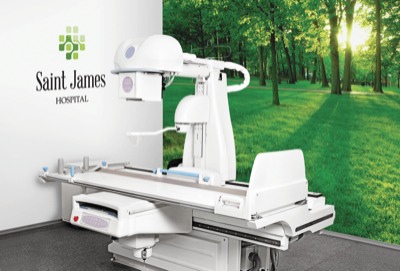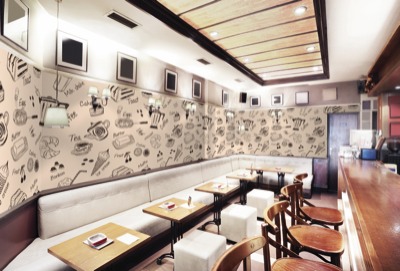Wall coverings are a growing application for Latex printing – this café was done by an HP user.
For the past five years HP has developed its range of large format inkjets with water based Latex inks. Now it’s facing competition from Mimaki and Ricoh. Simon Eccles reports.
Five years have passed since HP announced that it had developed an entirely new type of ink for large format inkjet printers. Today it offers a choice of five printers. This year it faces a new rival from Mimaki, which uses its version of a Latex ink, while Ricoh will launch a related model later this year.
Taking the HP ink first, in its launch announcement it said that Latex would have enough durability and fade-resistance to be used for outdoor signage work. The most important part was that unlike volatile solvent inks, it would be water based. This meant hardly any VOCs (volatile organic compounds), therefore little pollution, no health hazards to operators, no need to ventilate the presses, and no smell after printing. Recycling is good too, depending on the substrate.
The inks are dry as they come off the printer, unlike solvent that may be touch-dry but continues ‘outgassing’ for some hours. You can not laminate until outgassing finishes, which slows down outdoor and vehicle jobs that require this. Outdoor life is at least three years unlaminated, while window displays will last five years. The HP ink is suited to a very wide range of other applications, including indoor signage, POS, posters, wall coverings, vinyl and uncoated papers and even textiles.
Today there is a second generation ink option for higher black optical density, larger colour gamut, improved gloss, and improved durability. Running costs are lower too: the Latex ink costs less than the equivalent solvent, and users report lower waste, as you do not need to flush out the heads so often. Heads need fairly frequent replacement, but they are based on HP’s high volume office designs so they are fairly low cost and simply click in and out.
How it works
HP’s use of the word Latex is a little confusing, as in British English that often means a liquid rubber, which this is not. In the USA the meaning is more like what we think of as emulsion paint – there is no rubber and HP stresses that the ink is non-allergenic. The ink comprises polymer and pigment particles suspended in a liquid that is mostly water with additives to control its behaviour during and after printing.
During printing, the ink is jetted onto the media surface, which is warmed by radiant heaters and forced air. Initially the heating evaporates most of the water, leaving a viscous mix of wetting agent and humectant, polymer particles and pigment particles. In the case of vinyl media, this reacts to bond with the surface. Further heating as the media advances then coalesces the polymer into a film that locks in the pigments. The inks are stretchable so they are suitable for vehicle wraps.
 A Latex printed mural helps to cheer up this hospital room
A Latex printed mural helps to cheer up this hospital room
What’s the choice?
Today HP has expanded its family of Latex printers to five models, from the compact HP Designjet L26500 (1550 mm wide) and L28500 (2640 mm) at the entry level, through to the higher volume HP Scitex ‘industrial’ models, the LX600 (2640 mm) general purpose model (originally called L65500), LX820 (3.2 metres) and LX850 (also 3.2 metres but also suited to textiles, with more roll handling options). The two Designjet models use three pairs of HP 792 thermal heads to print a 43 mm swath at up to 1200 x 1200 dpi. The HP Scitex models use three pairs of HP LX600 or LX610 heads to print a 216 mm swath, so they are considerably faster than the Designjet models, but cost a lot more.
All models can print six colours: CMYK plus light magenta and light cyan. Unlike Mimaki’s alternative, there is no white ink. The Designjet L26500 (starting at around £22,000) and L28500 seem particularly attractive for commercial printers that might want to expand their range of products into large format, with the Latex inks allowing them to work on a particularly wide range of media.
 Designjet L26500 is HP’s entry level Latex printer
Designjet L26500 is HP’s entry level Latex printer
These are compact, office-style printers that will fit into fairly confined spaces. ‘Depending on the quality needed the Designjet L26500 in a normal ten-pass mode prints nine square metres per hour, up to 22.8 square metres for four passes,’ said Marchel van der Camp, sign and display market development manager at HP. ‘In the highest quality it is 6.3 square metres per hour, for the best photo quality with 16 passes.’ The larger HP Scitex models range from 39 square metres per hour in production mode (LX600) to 177 square metres in draft mode (LX850). ‘In the years after launch people found that the quality was so good that it could be used indoors too. So many customers swapped their Z-series aqueous Designjets for a Latex printer. So now they can address two markets with one printer.’
Although the process could be scaled down for smaller, lower cost printers, Mr van der Camp said that there does not seem to be any market demand for it. ‘There was a 42 inch machine announced at the 2008 introduction, but we actually only sold one unit,’ he said. ‘Larger media sizes mean you can print more square metres per hour.’ Jane Rixon, HP’s UK and Ireland channel business manager for large format, worked on the commercial HP Indigo press side until recently.
‘I’ve been to see HP Indigo customers for the past four years, in Scotland, North East England and Ireland,’ she said. ‘When I’ve told them I’m moving to large format, most of those customers have asked me to go back in and talk to them about the opportunities for large format Latex in that area. ‘It’s not just about environmental considerations,although that’s important, it’s the flexibility that Latex offers.
So as well as paper and vinyl materials, it can print on fabrics, wall coverings, all sorts of different things. With another technology you might need to buy two machines to do them all. ‘That’s what a lot of commercial print companies want to do, where it’s not necessarily their main expertise. Large format may be an add-on to their main businesses of brochure work and what have you. They want to add to their portfolio. Having done that, they often then go on to buy a second printer, perhaps a bigger one.’
Mimaki joins the fray
At drupa last year Mimaki announced that it was introducing a Latex printer that, unlike HP, would offer an opaque white ink. So far it has only one model, the JV400LX, in a choice of two widths, 1361 mm (for £17,995) and 1610 mm (£19,995), both including the company’s Rasterlink 6 RIP software. These machines compete mainly with the smaller HP Designjet L26500 model. Mimaki’s UK distributer is Hybrid Services, based in Crewe. Marketing manager Duncan Jefferies said that UK deliveries started early this year. ‘The LX latex model will be followed later this year by the JV400SUV, which uses a new solvent-UV hybrid ink, with LED curing,’ he added.
 The 1.6 metre version of the new Mimaki JV400LX.
The 1.6 metre version of the new Mimaki JV400LX.
The printheads are new piezo types called Gen-5, from Ricoh, with a 54.2 mm print swath. They are compatible with water, solvent, oil and UV-cured inks. Three droplet sizes are possible down to four picolitres, with eight greyscale levels. The JV400LX printers have eight ink cartridge slots and can configured for either CMYK +, CMYK or CCMMYK + white inks. The white ink is intended for printing backlit film transparencies and the like.
A continuous recirculation system keeps the heavier white particles dispersed evenly. The Rasterlink 6 RIP software provided can set up a print sequence of colour-white-colour if needed, for one-way window graphics or other types where the image is viewed from both sides and may need to be different. As ever, print speeds and quality vary according to the number of passes and the droplet sizes selected. In four colour mode, the draft mode speed is 18 square metres per hour (1200 x 900 dpi with six passes), Standard mode is 11.1 square metres per hour (900 x 900 dpi, 12 passes) and High Quality is 6.7 square metres per hour (1200 x 900 dpi, 12 passes). Colour-white-colour printing slows down to 1.7 square metres per hour at 1200 x 900 dpi, with 24 passes.
During printing a three-stage heater warms up and stabilises the media, through to final curing. The inks cure at around 60 degrees C, a relatively low temperature, the company claims, though adding that some media may need 70 degrees or higher. This allows the ink to be used with media that deforms or discolours at higher temperatures, such as PET film. It is suitable for normal outdoor sign media including banner material, backlit and bluebacked paper, as well as low cost uncoated papers.
It is also suitable for direct textile printing. It appears that the ink drying/curing works similarly to the HP ink. When in the cartridge the water forms a carrier for resin and pigment particles. Once jetted through the heads onto the heated media, the heat causes the resin to dissolve and form a membrane that locks the pigment particles onto the media.
Ricoh’s alternative
At drupa last year Ricoh also announced a forthcoming latex printer, called Pro L4000.At the show it readily confirmed that this is based on the Mimaki print engine (which uses Ricoh heads), and it will be available in the same two widths. However, it seems that this will not just be a straight badge engineering job, which explains why it is not available yet. ‘Ricoh is developing differentiation with the Mimaki,’ said Gareth Parker, Ricoh UK’s marketing value proposition manager. The launch is due by early autumn, he said, by which time the precise specifications and pricing policy will be clearer.
 Ricoh’s Pro L400 latex printer is due to ship by the autumn.
Ricoh’s Pro L400 latex printer is due to ship by the autumn.





